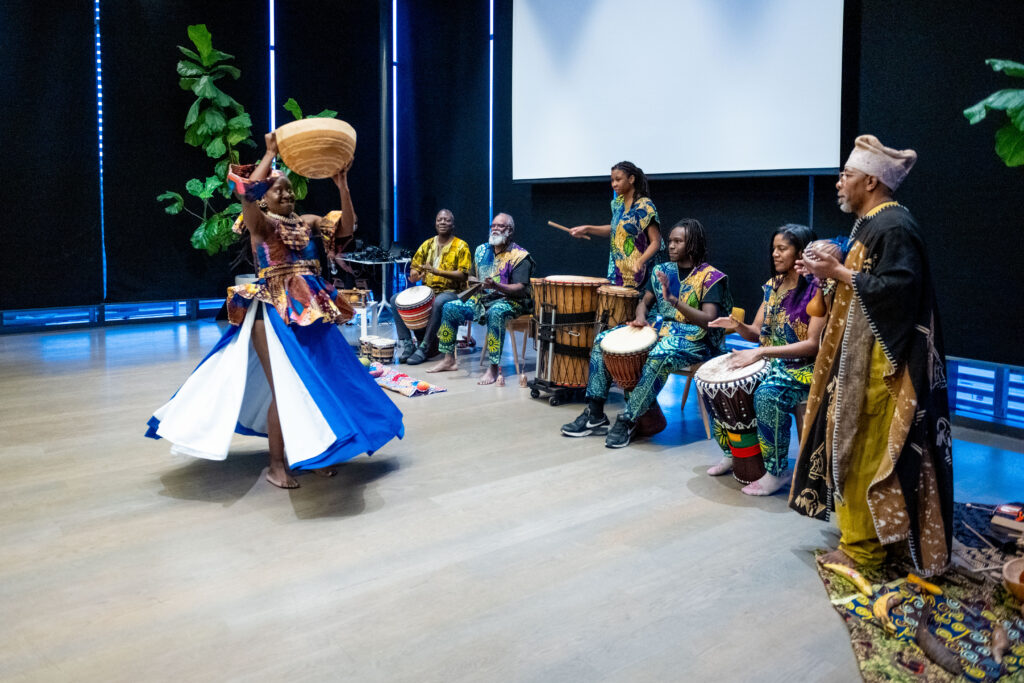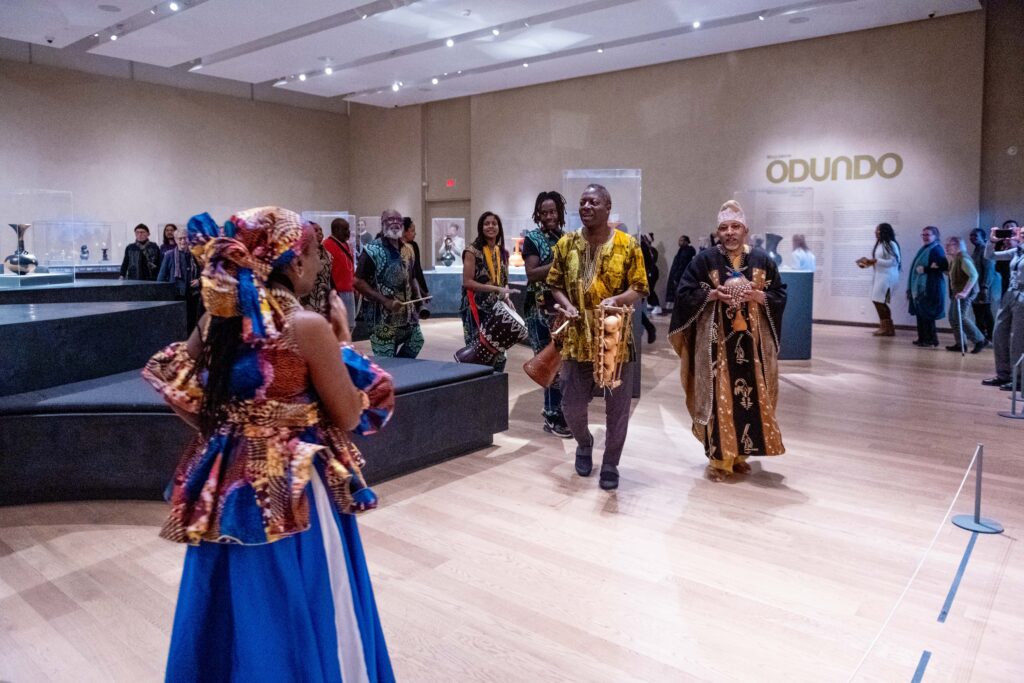
Collette Murray, a dance artist-scholar and York University PhD student in dance studies, is innovating what dance is, where it can be performed, and how it can promote decolonization, anti-racism and inclusivity.
For those attending Voices of the Diaspora, a special event at the Gardiner Museum tied to the largest North American exhibit Magdalene Odundo: A Dialogue with Objects, earlier this year, what followed an intergenerational panel discussion inspired by the work of ceramic artist Odundo likely came as a surprise to those unfamiliar with Murray.

The often-quiet rooms of the museum filled with music, and Murray – who curated an artistic response to this exhibition and moderated the panel – began to dance.
Drawing on decades of performance background in Caribbean folk, traditional West African and other diasporic dance styles, Murray interpreted Odundo's ceramic pots through Calabash, which is Coco Collective’s choreographic dance and live percussion narrative on how African diasporic communities engage in everyday social relationships with their vessels. Then, at the end of her performance, the musicians accompanying her stood up, and she asked the audience to join her in a community-engaged dancing procession throughout the exhibition.
As the group moved through the museum, Murray would blow a whistle and ask the audience to pose their bodies to echo moving shapes of Odundo’s work to the rhythms surrounding them.
For some attendees, the experience may have been a unique one, but for Murray it was a culmination of award-winning work she has been pursuing for more than two decades, looking to advance and reimagine what dance can do.

Murray joined York in 2010 already a successful dance performer in Ontario’s Caribbean and African arts community and Canada’s dance sector. She first pursued a bachelor of arts (specialized honours) in race, ethnicity and indigeneity in the Department of Equity Studies and a master’s degree in education. Currently, she is in School of the Arts, Media, Performance & Design pursuing a PhD in dance studies focusing on dance education and anti-racist pedagogies.
Among her ongoing interests, as displayed at the Gardiner Museum, is re-examining what dance is, what it can accomplish and where it can be performed.
“For many years, I’ve been trying to show dance teachers, practitioners and others that the range of dance shouldn't be so linear in scope,’” she says. “I’m truly trying to think outside of the box and show that dance can live anywhere.”
At the same, the Gardiner experience was reflective of a decolonial and anti-racism lens at the root of Murray’s work.
When asked to develop artistic responses and co-curate events for Odundo’s exhibit, among the first things she considered was, “How can I make equity-seeking communities feel like they belong in this type of space?”
Murray notes that, for a long time, museums have been dominated by a rigid standard around how they “should be” experienced: through quiet, non-disruptive contemplation. That standard is rooted in colonial practices that have socialized and gatekept whose cultural works are displayed, and how they should be treated.
Given Odundo’s British Kenyan roots, Murray wanted to cultivate a cultural arts experience that both reimagined those standards and evoked something more inclusive and authentic to the African diaspora via the integration of live music-dance storytelling and orality with the debut of Calabash and the community-engaged musical procession that was interwoven through the exhibition space.
“Often [in Western art and curation], fields are separate. The visual art is here. The dance is here. The music is here. The architecture and design is here. But for us, it's all together. It’s holistically integrated,” Murray says. “This is how African diasporic art practice lives. It’s not quiet and stagnant. It is alive, interactional and participatory.”
That’s why two pieces of feedback especially resonated following the Gardiner Museum event. “I received compliments, especially from members of the African diaspora who said, ‘I felt like I was at home,’ and a patron stating on social media, 'This is what decolonizing the museum looks like,'” Murray says. “That was a huge compliment to the work.”
In the same way that Murray seeks to re-examine dance as performance and curation, she is also doing so with academic endeavours. At York, she has pursued research that has explored and identified gaps in scholarly literature related to African Canadian diasporic dance communities.
She has also conducted work – centred on the experiences and perspectives of Africa, Caribbean and Black art educators – uncovering the successes and challenges of culturally responsive artists teaching in the Ontario education system.
Murray’s work has already earned her several awards, including: the 2023 National Award for Outstanding Leadership in Justice, Equity, Diversity from the U.S.-based National Dance Education Organization; the 2022 Award for Racial Justice in Creative Arts from the Urban Alliance of Race Relations Canada; named among the 100 Accomplished Black Canadian Women honorees in 2020; and more.
For Murray, the awards and the reception to her Gardiner Museum experience are affirming. “I've always had these ideas, and you never know if and when you manifest them, if it translates to the intended audiences,” she says.
Looking ahead, Murray has no plans to stop finding ways to innovate the art she loves and the issues she cares and advocates for. In fact, she will once again be bringing dance into museums next month, with a three-month exhibited work at the Ken Seiling Waterloo Region Museum. The Black and Free exhibition includes her present work titled Un loc’ de riddims in meh body that aims to bring a dance dialogue of Blackness and liberation into the space. As the description of her work explains, it will be “a visual journey amplifying how a dancing body is a transnational archive in geopolitical spaces across the African diaspora that exists, claims space, and sustains nuances of being when presenting and engaging in embodied dance practices. Constructed from lived experience, archival and dance photography, and performance – Murray decolonializes and defines what it means to be an Afrodescendant displaying freedom.”
The exhibit, like the Gardiner Museum experience, promises to once again illustrate the inventive ways Murray is reimagining the boundaries of what dance can do and where. Her upcoming feature article in the Canadian Theatre Review continues this discourse of how Black dance in Canada lives beyond the proscenium stage. “I will challenge but invite the audiences to learn beyond their assumptions of our dance practices,” she says.
